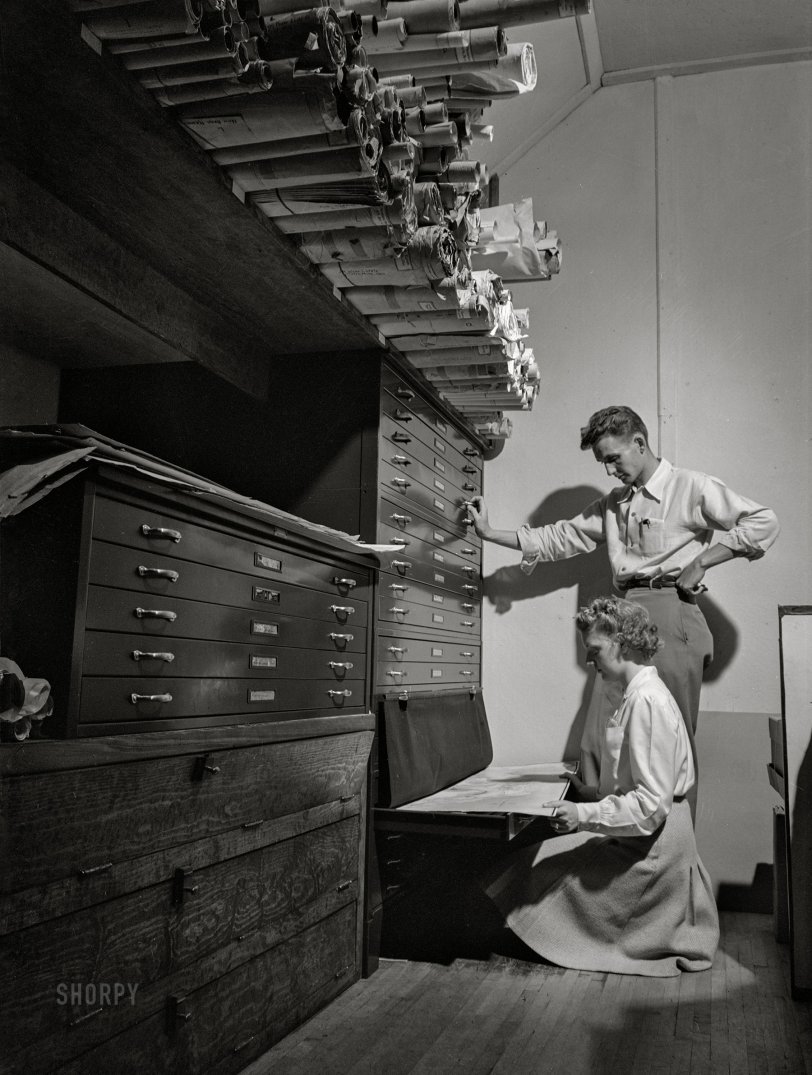


Framed or unframed, desk size to sofa size, printed by us in Arizona and Alabama since 2007. Explore now.
Shorpy is funded by you. Patreon contributors get an ad-free experience.
Learn more.

- Roll your own
- Rugged and real!
- A Charles Purcell - Mama Cass Connection
- Uncle SAAM
- Obfuscation
- One Chocolate Soldier rode away
- Victor Marquis de la Roche
- The Little House Across Way ...
- Vanderbilt Gates
- Vanderbilt Mansion
- You can still see that gate
- Withering heights for me
- So Jim,
- Top Heavy
- Re: Can't Place It.
- Bus ID
- Since you mention it
- The White Pages ?
- Moonlight Tower
- 1907?
- Fire(men) and Water
- Can't Place It
- Can anyone
- Wings
- Where's Claudette and Clark?
- Overbuilt Rolodex
- One song
- Give Me Wings Please!
- PRR
- Pinball Wizards
Printporium
Mary & John: 1942

May 1942. Ames, Iowa. "Miss Mary Louise Long of Chicago and John Staley of Maryland look up drawings in the files at the landscape architecture building at Iowa State College." Acetate negative by Jack Delano for the U.S. Office of the Coordinator of Information. View full size.
Archived drawings
It's true that copy methods such as Xerox weren't around when this photo was made, but drawings could still be reproduced, and fairly cheaply.
Drawings stored in those flat files likely were original, hand-drawn plans in ink or pencil on linen or (paper) vellum. The process a hundred years ago would have been blueprinting. At the time of this photo it would have been blue-line (diazo) printing.
True blueprints are before my time, but pen and ink drafting and blueline printing were part of my livelihood "back in the day". Starting in about 1980, computer drafting began to make inroads, though drawings were still printed out first on pen plotters and later on large-format inkjet printers and then reproduced by blue-line.
Today things are pretty much universally digital -- computer drafting, digital storage and direct printing.
Iowa State (Ames) was my school, too. That Architecture department had a focus more on technology than design. One result of that was that people who were great at drawing and design but weak in the engineering courses ended up in the Landscape Architecture program, where they did beautiful drawings that put the architects to shame.
JHS
John Hedges Staley Jr. (1918-2015)
Occupation in 1950: Landscape Architect
Must have!
I love those drawers! Perfect for artwork paper. And treasure maps!
Their great grandchildren will never know
what it was to go through drawer after drawer of drawings, maps, etc. to find what you're looking for. Then you had to make a sketch or write a description of what you wanted to remember, because copiers didn't hit the market until 1959 and you would have to use up a whole roll of film if you took a photograph. How did Mary Louise and John ever get anything done?
[1959 was when the Haloid Xerox plain-paper office copier was introduced. (The Haloid Model A xerographic copier came out in 1950.) Filmless photocopiers (Photostats) for large documents like architectural drawings go back to the early 20th century. - Dave]
























On Shorpy:
Today’s Top 5